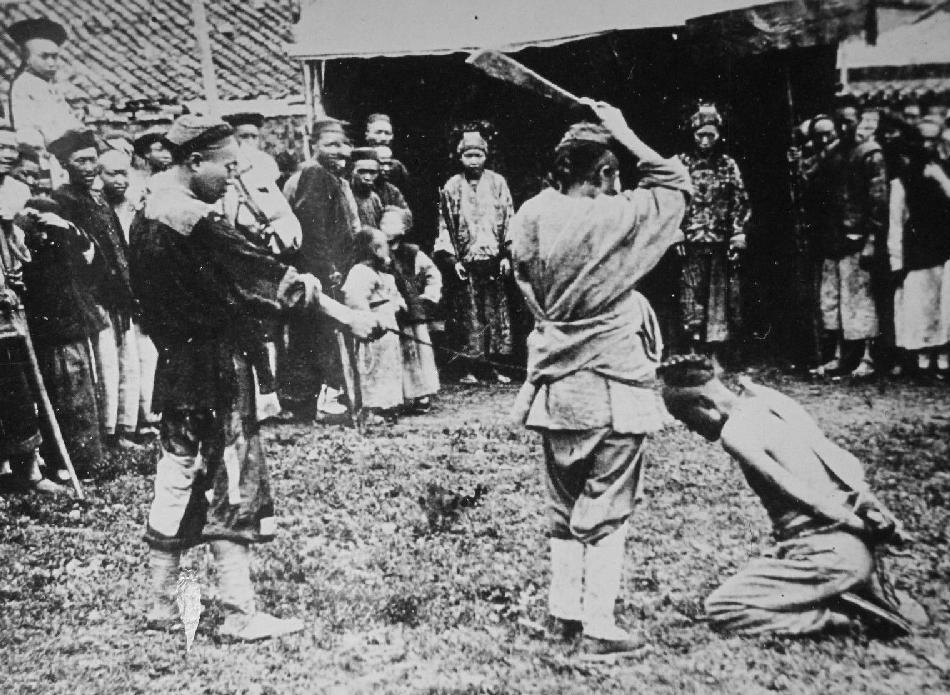
The Boxer Rebellion: Aftermath (1900-01)

Figure 1.--Many Boxers were executed during the insurgemcy. The Japanese beheaded the Boxers they captured. The Boxer Protocol entailed the execution of the 12 ringleaders. The Imperial Government actually executed many more Boxers, after the failure of the Rebellion. This photopgraph had no accompaning informtiom but it looks to be authorities executing a Boxer. It does not look like the foreigners or Imperial authorities. Perhaps local authorities or a prominenly land owner has ordered the execution. Notice how the man's pigtail is being used to position his neck. There are women and children watching the execution, including a boy on a horse. That would have meant that he came from a high-ranking family.
|
|
The Dowager Emperess set up her court in Xian and sent Li Hongzhang for peace talks. He was a Qing/Manchu prince. There was little neotiation. The representatives of 11 foreign powers imposed the Protocol of 1901 or Boxer Protocol on China (September 7, 1901). For letting the Boxers get out of hand and in part using the Boxers, the foreign powers punished China for disrupting foreign economic and religious interests. China was forced to pay a stiff price for peace. The Protocol imposed a penalty prescribed death or exile for the 12 Rebellion ringleaders. Actually many more Boxers were executed, often by beheading. An array punishments were designated for 119 provincial officials. The Imperial Government was required to suspend civil service exams for 5 years in the 45 districts in which the Boxers rose. The Protocol imposed a 450 million tael indemnity which had to be paid yarly installments over the next 39 years (Computing interest and an unfavorable exchange rate imposed in the Protocal, the actual total ran closer to 980 million taels). The Protocol enlarged the Peking legation quarter which the Imperial Government found particularly insulting. The foreign powers essentially were given the run of the place and protected by a a permanent guard of their own. To atone for the deaths of two ministers (von Ketteler and Sugiyama), the Imperial Government had to send 'apology' delegations to Germany and Japan. The Imperial Government was forced to prohibit all anti-foreign organizations. Weapons imports were banned for 2 years. Military forts located between Peking and the sea had to be dismantled. The foreign powers were authorized to use their troops to monitor 12 routes into Peking. The reparations and concessions imposed on China under the Peking Protocol descredited the Manchus in the eyes of the Chinese people. The Emperess Dowger managed to return to the Forbidden City a year later. The power of the Imperial system and the Manchus was, however, substantially broken. The Emperess managed to hang on another decade, but the imperial system was irevocanly broken. The Manchus were finally overthrown by Republican forces (1912). The United States was one of the countries that had participated in the relief mission. There were, however, no American treaty ports. The United States called for an expanded Open Door policy in the discussions following the relief mission. American Secretary of State John Hay called for the open door to extend to all regions of China. The Europeans and Japanese dismissed the idea.
CIH

Related Chronolgy Pages in the Boys' Historical Web Site
[The 1880s]
[The 1890s]
[The 1900s]
[The 1910s]
[The 1920s]
[The 1930s]
[The 1940s]
[The 1950s]
[The 1960s]
[The 1970s]
[The 1980s]
[The 1990s]
[The 2000s]
Related Style Pages in the Boys' Historical Web Site
[Long pants suits]
[Knicker suits]
[Short pants suits]
[Socks]
[Eton suits]
[Mao jacket]
[Jacket and trousers]
[Blazer]
[School sandals]
[School smocks]
[Sailor suits]
[Pinafores]
[Long stockings]
Navigate the Children in History Website
[Return to the Boxer rebellion page]
[Return to the Main Chinese 20th century page]
[About Us]
[Introduction]
[Biographies]
[Chronology]
[Climatology]
[Clothing]
[Disease and Health]
[Economics]
[Freedom]
[Geography]
[History]
[Human Nature]
[Ideology]
[Law]
[Nationalism]
[Presidents]
[Religion]
[Royalty]
[Science]
[Social Class]
[Bibliographies]
[Contributions]
[FAQs]
[Glossaries]
[Images]
[Links]
[Registration]
[Tools]
[Children in History Home]
Created: 11:44 PM 7/1/2016
Last updated: 11:44 PM 7/1/2016



